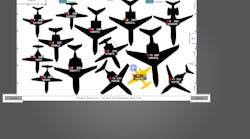Playing Tetris is a fun game and also is a great way to pass the time. However, playing “live” Tetris with multi-million dollar jets is never a good idea. But, unfortunately, it is happening daily at fixed base operations (FBOs) across the country.
Aircraft ground damage, commonly referred to as “hangar rash,” is costing our industry millions of dollars every year.
Many FBOs have towing policies in place that include wing walkers, whistles and various other safety measures. These policies have substantially reduced hangar rash incidents, however, they still do not address one very critical component. There is absolutely no way for an FBO to know what will fit in their hangar without using the archaic, wasteful, risky business of towing aircraft around to see what fits.
In many ways, aircraft hangar stacking has not changed, and neither has the way we think about stacking hangars.
In order to eliminate the outdated practice of manually stacking hangars, I have worked with my business partner and award-winning software expert, Steve McNeilly, to create Hangarstack.
Hangarstack is a software program we created to remove much of the guesswork involved with stacking hangars.
FBOs can use the cloud-based software, which is compatible with PCs, laptops, tablets and smartphones, to come up with a parking plan that minimizes towing aircraft around to see what fits inside the hangar – or on the ramp space.
Meanwhile the FBO’s front desk staff can utilize features to get an accurate depiction of what is currently in the hangar and if there is any space available.
With this knowledge, they can accurately say yes or no to a paying G5 customer that inquires about hangar space for the night. Just saying you have space based on guesswork is not good enough because aircraft left out overnight during subzero temperatures will freeze and cause substantial damage to water systems.
Having many years of experience running an FBO myself led to specific Hangarstack developments.
For example, the aircraft are not “dragged and dropped” into a hangar, instead they are actually moved around via the nose wheel pivot point on the aircraft.
This allows the user to move airplanes within the program at real-time angles with respect to the hangar shape or ramp space shape.
Trust and confidence are so important in this business. It’s one thing to say your safe, or that safety is a priority, etc. But the days of a simple handshake are long gone.
When you have a software program that can visually show your customer how and where you will be parking there aircraft, it speaks volumes about your operation and how you intend to take care of their multi-million dollar asset.
I have been through hangar rash incidents over the years and have seen firsthand how these events destroy relationships and waste valuable time and money.
A software platform will never replace the human element of aircraft towing. However, it can provide the opportunity to put a solid plan in place before a single aircraft is towed, which can make a very large impact on the safety of our operations and industry.







